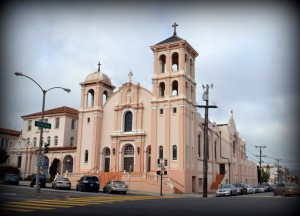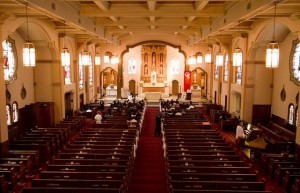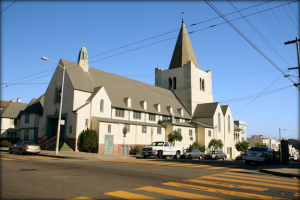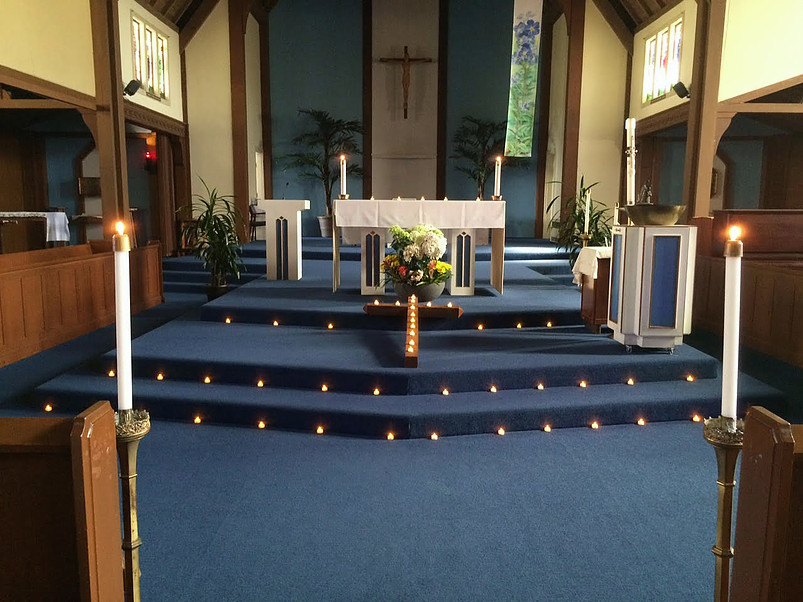Please read the enclosed decree regarding the canonical merge of St. Monica Parish and St. Thomas the Apostle Parish.
12-8-16 Canonical Merge Decree
 *For the history of St. Monica Parish, please see the enclosed article that was published in Catholic San Francisco (2011).
*For the history of St. Monica Parish, please see the enclosed article that was published in Catholic San Francisco (2011).
October 12th, 2011
By George Raine
On Jan. 22, 1911, Father Edward Doran celebrated the first Mass at St. Monica Church in San Francisco – although it was not the elegant building you’re familiar with at Geary Boulevard and 23rd Avenue.
The first St. Monica was a vacant store on the southwest corner of Geary Boulevard and 27th Avenue. Twenty-eight people attended the first Mass, including Theodocia Oliver, who noted the event in her diary. Here, too, confessions were heard and babies baptized.
The next address for St. Monica was on 25th Avenue between California and Clement streets, and the third is the present site, blessed in June 1918 – a church that would become one of the largest, if not the largest, in San Francisco, as the city developed westward and the Catholic population swelled in the mid-20th century.
On Oct. 23 at 10:30 a.m., the current pastor, Father John Greene, will celebrate St. Monica’s 100th anniversary Mass – and honor a church with a history that reflects the San Francisco story.
“It has a tremendous amount of tradition,” Father Greene said of St. Monica. “For a small parish, the parishioners have a lot of involvement – people getting into ministries. Tradition is a big part of St. Monica. There is pride in the parish, continuing things that have been done for many years.”
Following the great earthquake and fire of 1906, the Richmond District was known as Carville, because so many displaced people were living in streetcars. Star of the Sea Church had been built in 1894 at Geary and Eighth Avenue, and 100 years ago St. Monica was established to help accommodate the overflow of Star of the Sea and growth in the district.
Theodocia Oliver, her husband, Eugene, and their daughter, Mary, of Sea Cliff, were all at the first Mass that Sunday in 1918 in the new church. Theodocia wrote, “It was a grand ceremony, a high Mass.”
The granddaughter of Eugene and Theodocia Oliver, Olivia Fisher, 90, has for most of her life been a parishioner at St. Monica, a few blocks from where in 1932 her father built the house – amid sand dunes – in which she lives today. She walks to Mass daily and she will be there for the centennial celebration.
“To me, the miracle is that three people (her grandparents and mother) were here 100 years ago and their granddaughter is still there and will be at the dedication of 100 years of St. Monica,” said Fisher, who had a long career as a public school teacher and who for 15 years was a volunteer at St. Monica School teaching second grade and folk dancing.
In 1919, St. Monica School opened with the Sisters of the Holy Names of Jesus and Mary as teachers. They presided for generations, followed by Sisters of Charity of the Blessed Virgin Mary – Sister Anne Kendall, the principal, 1994-2002, and Sister Peggy Devereux, a religion teacher, 1995-2002.
As Father Greene put it , church and school developed “on the installment plan.” The school was doubled in size in 1938 and the church was doubled in 1951; some 30 stained glass windows were added to the church in 1926 (depicting the life of Jesus) and again in the early 1950s (the life of Mary), and the organ was installed in 1936 and rebuilt several years ago.
, church and school developed “on the installment plan.” The school was doubled in size in 1938 and the church was doubled in 1951; some 30 stained glass windows were added to the church in 1926 (depicting the life of Jesus) and again in the early 1950s (the life of Mary), and the organ was installed in 1936 and rebuilt several years ago.
The quality of the construction and craftsmanship, Father Greene says proudly, is first class, including the work of noted architect Arnold Constable, who designed the church’s expansion; the reredos, or altarpiece honoring the four evangelists and Christ the King, carved in Germany; the stained glass windows from Franz Mayer & Co. in Munich; the Kilgen organ, rebuilt by Schoenstein & Co. of Benecia, the brass candleholders by Dirk van Erp, the Dutch-American artisan, and more.
“Everything here, they bought only the best,” said Father Greene.
The pastor who presided over the growth and attention to detail was Father William Cantwell, who served from 1929 to 1962. He was said to be very popular and, as Fisher recalls, was from County Tipperary and swung his walking cane back and forth as he visited parishioners.
St, Monica, said Fisher, has been blessed with excellent priests.
“Father Greene is very spiritual,” she said. “Every day he gives us a talk both on the reading and on the Gospel and always makes it relevant to what is happening today.”
The parish population grew dramatically, from the 1930s into the 1960s, to 4,000 families. It has 400 now. The demographics of the district have changed, too, with the departure of many Irish and Italian families, and influx of Asians – there’s a Cantonese Mass on Sunday – but people from as far as Daly City and Pacifica and even Vallejo attend Mass at St. Monica, simply because “they like it,” said Father Greene. In addition, Father Greene serves as chaplain of the San Francisco Fire Department and has a steady routine of funerals, marriages and other services for firefighters and their families.
Ninety-year-old Olivia Fisher is the lector at the Monday Mass. “The church is a source of spirituality,” she said. “We grew up as children knowing the church is important.”
At a glance
– St. Monica grew with San Francisco’s mid-20th century westward expansion.
– St. Monica School opened in 1919 with the Sisters of the Holy Names of Jesus and Mary as teachers.
– St. Monica’s litany of illustrious pastors includes Father William Cantwell (1929 to 1962), who hailed from County Tipperary and swung his walking cane back and forth as he visited parishioners.
From October 14, 2011 issue of Catholic San Francisco.
*For the history of St. Thomas the Apostle Parish, please see the enclosed text from the Twenty-Fifth Anniversary Souvenir Booklet (1948).
 This year marks the twenty-fifth anniversary of the celebration of the first mass in St. Thomas’ church. The parish of St. Thomas the Apostle had its origin in a division of St. Monica’s parish. The boundaries of the new parish were established as follows: Beginning on the west side of 33rd Avenue, they extended to the ocean; the southern border began on the north side of Fulton street and extended to the Golden Gate strait. Since that time, the southern border was extended to the north side of Lincoln Way.
This year marks the twenty-fifth anniversary of the celebration of the first mass in St. Thomas’ church. The parish of St. Thomas the Apostle had its origin in a division of St. Monica’s parish. The boundaries of the new parish were established as follows: Beginning on the west side of 33rd Avenue, they extended to the ocean; the southern border began on the north side of Fulton street and extended to the Golden Gate strait. Since that time, the southern border was extended to the north side of Lincoln Way.
Ground was broken for the original church on December 21st, 1922. Work progressed steadily from that date and on Christmas Day of 1923, the first mass was celebrated by Father Thomas A. Chrimmins, the first pastor of St. Thomas’ parish.
The church occupied the present site at the southeast corner of Balboa Street and Fortieth Avenue, and at that time accommodated only 292 persons.
The rectory was built immediately after the completion of the original church. (The architect and contractor were the same as for the church: Caldwell and Bryant.) The cost of building and equipping the first permanent rectory was $36,000. When the church and rectory were completed, the first pastor, Father Crimmins, realized that ground should be secured for extension of the church at some future date and also for a future school. He purchased two lots on Fortieth Avenue, two lots on Balboa Street to the corner of 39th Avenue, and four lots on 39th Avenue, thus assuring space for future development. The cost of these lots was $10,500.
 In 1927, Father James P. Moran succeeded Father Crimmins as pastor. In 1929, by reason of the growth of the district, it was deemed necessary to extend the church to take care of the new parishioners. A meeting of parishioners was called and it was agreed that the church should be extended to accommodate 750 people. In the beginning of 1930, this task was begun and the work was completed in December of the same year. The cost of this project, which was paid for through subscriptions, was $31,910. There remained, however, a large debt on the parish, which was gradually liquidated. By 1946, the parish was completely out of debt.
In 1927, Father James P. Moran succeeded Father Crimmins as pastor. In 1929, by reason of the growth of the district, it was deemed necessary to extend the church to take care of the new parishioners. A meeting of parishioners was called and it was agreed that the church should be extended to accommodate 750 people. In the beginning of 1930, this task was begun and the work was completed in December of the same year. The cost of this project, which was paid for through subscriptions, was $31,910. There remained, however, a large debt on the parish, which was gradually liquidated. By 1946, the parish was completely out of debt.
In October of 1946, Father Stephen F. Barron was appointed administrator of St. Thomas’ parish. Plans were drawn up for the new school by the architect, Mr. Vincent Buckley, and work on the school was begun on August 20th, 1947. Both school and convent will be ready for the 1948 Fall Term.
From 1948 Souvenir of the Twenty-Fifth Anniversary St. Thomas Parish and Completion of St. Thomas School San Francisco 1923-1948.